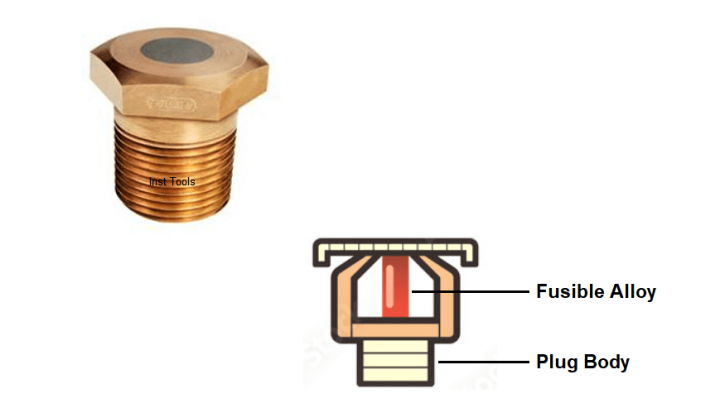History of fusible plug
In 1803, Richard Trevithick invented the threaded fusible plug. After one of his own boilers exploded during a water leak, he was determined to make a detection device that could offer a means of prevention.
What is a Fusible Plug?
Fusible plugs are safety devices that contain a material, which melts at a pre-determined temperature and then releases pressure.
A fusible plug is the ultimate safety measure expected to prevent a catastrophic failure that may prove harmful to the plant and personnel working.

They consist of a hole that is plugged with an alloy melting to a pre-set temperature. It may be any temperature value higher than the maximum ambient temperature (30° C, or 70 ° C, or 100 ° C).
They are used as safety equipment with the directive to take fire and automatically activate all the sequences to protect the plant and to safeguard the people.
Because of their important safety service, it is necessary that fuse plugs, as well as all the other components included in the system, are designed, manufactured, and installed in the correct way.
A few manufacturers consider the fuse plug a poor component.
There are a wide variety of safety devices put in place to ensure the safety of electrical, as well as mechanical machines.
Material of construction
Fusible plugs are formed with a tapered hole, this hole runs the entire length of the fastener. Materials of construction are brass, bronze, or gunmetal.
The hole is then fixed with a metal sealant, such as tin or lead.
What is a Fusible Loop System?
The fusible loop system consists of a fusible plug, tubing network, network loop pressure transmitter/switch.
One pressure transmitter or pressure switch is connected across a tubing network consisting of fusible plugs.
Where do we use them?
We mentioned some of the example applications of fusible plug in the below sections.
Electrical equipment
Fusible plug loop systems are installed near the electrical motors of critical applications, or transformers in an oil and gas plant.
In case of the eventuality of fire, fusible plugs get melted due to the surrounding fire. Pressurized air is released from the same fusible plug holes.

A pressure transmitter or pressure switch connected in the loop gets depressurized, an ESD alarm will alert the operator in the control room.
The next step is to extinguish the fire, which will be initiated.
Steam Engines
A fusible plug, also known as a safety plug, or threaded fusible plug. It is one such safety device that is commonly used in steam engines. It ensures that in case of water levels recede to dangerous levels, operators will be alerted by a strong stream of steam, allowing them to take action.
Once in place, the fusible plug carries a good one-inch effect on the water space above it. It works by heating up when the tip is no longer submerged in water, indicating that the levels are too low. As it overheats, its sealant melts, allowing it to become a simple whistle, just like a cup of tea.
This is considered a last resort, as the water level so low at this point would already prove dangerous.
The danger is in the heat of the steam engine’s combustion chamber, particularly that of the combustion gases. They can reach up to 550 ° C, which is dangerous to both the engine and humans.
Aircraft Wheel tire
As a safety measure, to avoid the explosion of tires because of over pressurization due to breaking heat, fusible plugs are provided in all tires’ of aircraft wheels.
Apart from the above, fusible plugs are used in air compressors, refrigeration systems for equipment protection that arise due to high temperature.
Advantages of Fusible Plug
- Fusible plugs are simpler and don’t require any maintenance.
- Fire protection can be provided in a surrounding fusible plug radial field.
- The system is very cost-effective.
Disadvantages of Fusible Plug
- Although useful, threaded fusible plugs can fail. If the sealant rusts or fouls as it ages, it can damage the reliability of the plug.
- Formation of rust conditions can increase the melting point of the metal, which does not react when heated. Some fuse plugs fail to activate even after being exposed to higher temperatures.
- Fusible plug system is slower than heat detectors.
- In some areas, fuse plugs must be replaced after thirty to sixty days of use. This is as per local regulations.
If you liked this article, then please subscribe to our YouTube Channel for PLC and SCADA video tutorials.
You can also follow us on Facebook and Twitter to receive daily updates.
Read Next:
- Manual Call Point
- Photoionization Detector
- Basics of Fire Extinguisher
- Fire Fighting Hydrant System
- Infrared Open Path Gas Detector
GREAT!